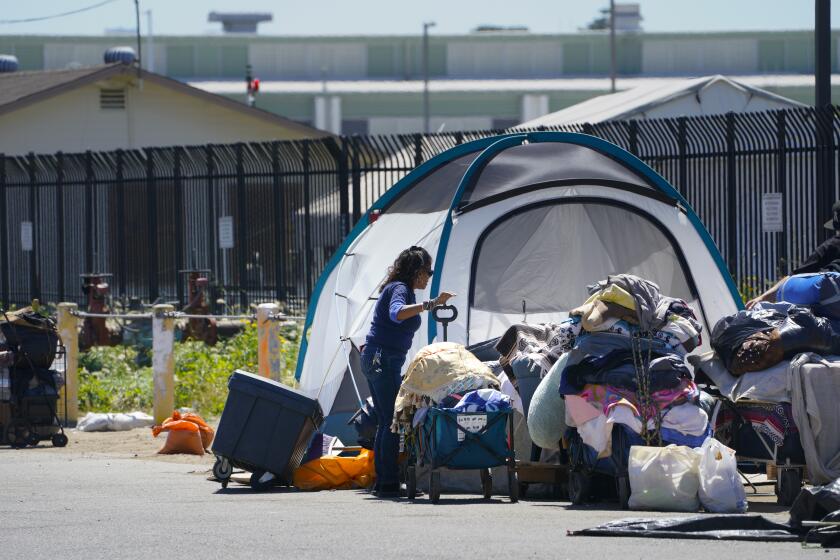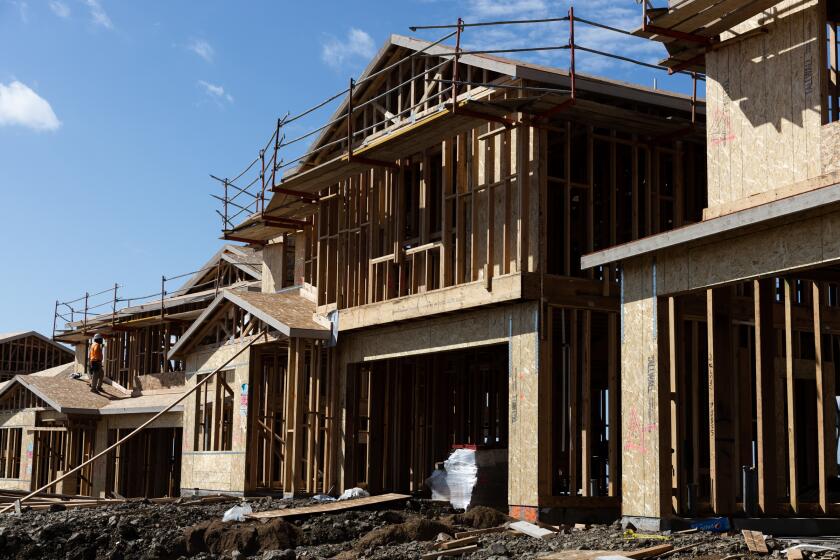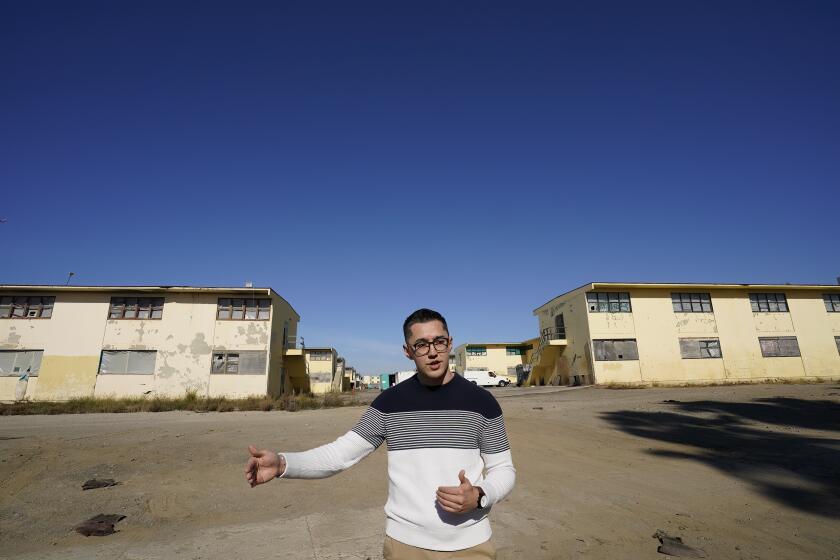Column: Despite crime increase, San Diego remains among safest big cities. Why is that?

Theories abound, but there’s no clear explanation for city’s relatively low violent crime rate.
San Diego has long had fewer police officers per capita than other big U.S. cities — sometimes by a lot.
Yet the city remains one of the safest major metropolitan areas, even with the recent increase in crime. The possible explanations for both are many, though they are not crystal clear.
This story is for subscribers
We offer subscribers exclusive access to our best journalism.
Thank you for your support.
Regardless, the yearslong decrease and current rise in crime mirror national trends.
First, some perspective into the bump in crime is warranted. Any increase is cause for concern, especially when that increase crosses almost all crime categories — with the rise in violent crime most worrisome.
But the rate of violent crime has been basically flat for the past decade. It rose from 3.71 per 1,000 residents in 2020 to 4.16 in 2021. In 2012, violent crimes were 4.2 percent per capita. The overall crime index rate, which includes property crimes, also has increased, but is notably lower than a decade ago.
The San Diego Police Department said the current violent crime rate is comparable to what it was in the mid-1970s, before it spiked in the 1980s and into the 1990s, when the local crime rate was above the national average.
Lyndsay Winkley of The San Diego Union-Tribune for years has covered public safety issues. A few years back, she wrote how San Diego regularly logs the lowest homicide rate among the top 10 major U.S. cities and in 2017 had the lowest violent crime rate in that group.
“Given that we are such a large U.S. city, I don’t think anyone would be surprised if our crime rate was higher,” Cynthia Burke, the director of research and program management at the San Diego Association of Governments, said at the time. “I’m baffled by it.”
The recent statistics show San Diego no longer has the lowest homicide rate, but it’s still close. The city had .04 homicides per 1,000 people last year while Dallas and San Jose had .03. For comparison, the rate in Los Angeles was more than twice that at .10 homicides per 1,000 residents.
Criminologists have shared with Winkley various theories about why San Diego is a comparatively safe place.
One of them is a relatively quiet urban core. San Diego may be one of the nation’s largest cities, but it also is very much a suburban city with distinct neighborhoods ringing downtown and beyond.
Also, San Diego has gangs but they don’t seem to be as historically entrenched here as in, say, New York, Chicago or Los Angeles.
Some experts suggest San Diego’s large immigrant population has something to do with its lower crime rate. Immigrants often arrive with, or join, families with children and grandparents, sometimes living in the same house. That brings up the collective income and can provide more supervision for children — both of which can deter crime.
Depending on immigration status, there’s also the potential of being deported for running afoul of the law. Also, undocumented residents can be reluctant to report crime, which could artificially suppress the rates of some crimes.
More universal theories for lower crime here and elsewhere include a decline in the crack trade, an increase in data-driven policing and an aging population. The popularity of video games also has been cited as occupying the time of young males, a higher crime-committing demographic than most.
Mass incarceration has also been credited — not without controversy — for keeping criminals off the streets. In California, critics blame some of the recent increase in crime on Proposition 47, the voter-approved 2014 initiative that changed sentencing laws and led to the release of lower-risk inmates. However, that doesn’t explain the parallel nationwide increase in crime.
Meanwhile, the San Diego Police Department has clearly done more with less for a long time. San Diego currently has 1.3 officers per 1,000 residents — lower than most other major cities. In Phoenix it’s 1.7, Dallas 2.3, Los Angeles 2.5, New York 4.1 and Chicago 4.7.
SDPD’s officer corps is perpetually below budgeted staffing. Recruitment and retention remain an ongoing concern. City police have shown, for the most part, they can be effective in considerably smaller numbers than in other cities. But if proactive policing is reduced because officers are too busy responding to 911 calls, that’s a problem.
Positive police interaction with neighborhood groups can help prevent and fight crime. The San Diego Police Department has had stretches of good community relations over the years, though currently those ties are strained — as they are in some other cities.
Social unrest following the murder of George Floyd by a Minneapolis police officer in 2020, along with other high-profile use-of-force incidents, have raised suspicions between police and some residents, particularly in communities of color. Even before then, there was tension in San Diego over tougher police enforcement against people of color that has been documented in repeated studies, which also eroded trust.
It seems obvious, but any discussion of the increase in crime has to mention the increasing number of guns, legal and not, across the country.
Then there’s the pandemic. San Diego Police Chief David Nisleit is not alone in suggesting that’s been a key driver in the increase in crime.
“It’s COVID. It’s people being out of work, kids being out of school, just the anger and the frustration levels of everything over the last two years,” Nisleit said. “I think we need to acknowledge the last two years have been difficult on everybody.”
Beyond that, the political and cultural divisions nationwide have taken on a sharper edge. Hate crimes in San Diego and just about everywhere are way up. Public pressure and social standards that may have tamped down the evil id in many people have weakened.
More people believe they have the license to act badly — publicly and physically. Witness the disturbing incidents of passengers disrupting flights and sometimes assaulting flight attendants over minor things, such as the requirement to wear a mask.
Moves to slash police budgets in San Diego and other cities following the Floyd protests fizzled out as crime numbers rose. The SDPD budget has increased, as have other law enforcement budgets.
But while the appropriate size and duties for SDPD can always be debated, what’s happening with crime — whether up or down — is about a lot more than police funding.
Tweet of the Week
Goes to Mark Z. Barabak (@markzbarabak), Los Angeles Times columnist.
“We shall pay any price, bear any burden, meet any hardship, support any friend, oppose any foe to assure the survival and success of liberty.” — John F. Kennedy
Get Essential San Diego, weekday mornings
Get top headlines from the Union-Tribune in your inbox weekday mornings, including top news, local, sports, business, entertainment and opinion.
You may occasionally receive promotional content from the San Diego Union-Tribune.












